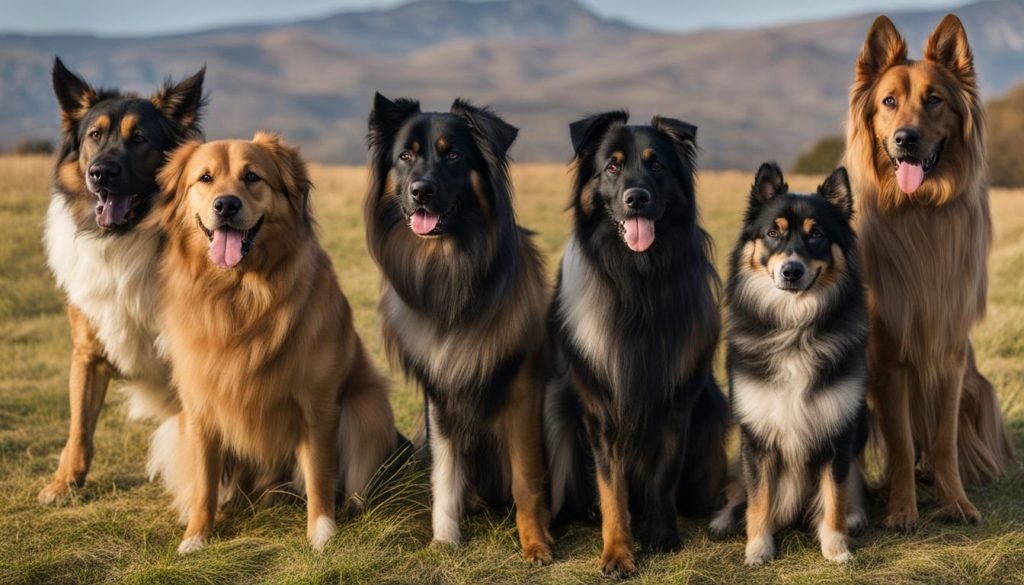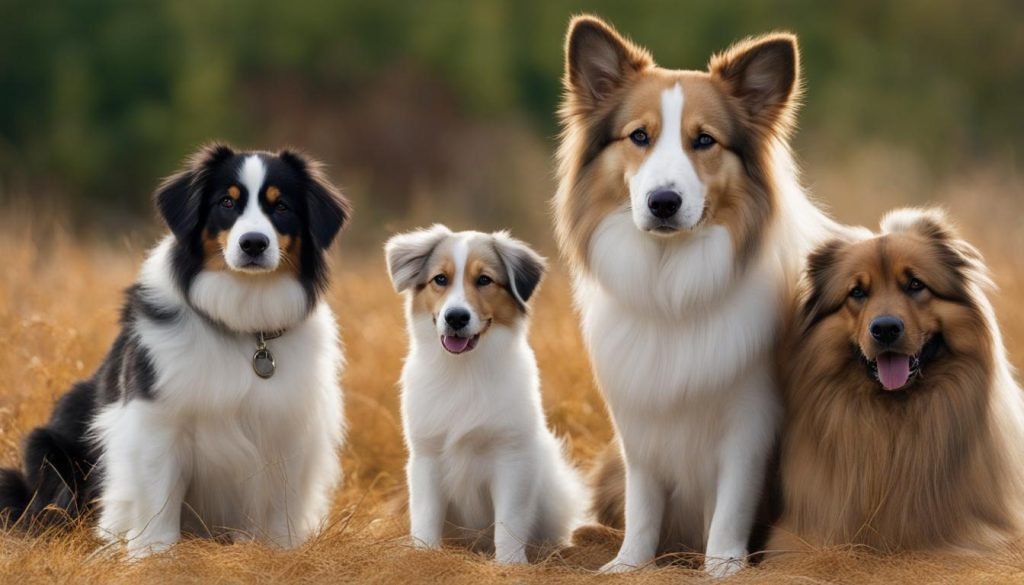How Many Dog Breeds Are There? Dog Breeds Worldwide
Dogs have been cherished companions of humans for centuries, offering love, loyalty, and joy to millions of households around the world. But did you know that there are over 300 recognized dog breeds worldwide? Each breed showcases its unique characteristics, appearance, and temperament, making the world of dogs incredibly diverse and fascinating.
Identifying and classifying dog breeds is not only an interesting pursuit but also essential in various domains. From healthcare to behavior traits and responsible breeding practices, understanding the different types of dog breeds plays a significant role in providing optimum care and enhancing our knowledge of these remarkable creatures.
Key Takeaways:
- There are over 300 recognized dog breeds worldwide, each with its unique characteristics, appearance, and temperament.
- Identifying and classifying dog breeds is important for various domains, including healthcare, behavior traits, and responsible breeding practices.
- The world of dogs is incredibly diverse and fascinating, offering a wide array of sizes, purposes, and origins.
Why is Dog Breed Identification Important?

Identifying and classifying dog breeds is a cornerstone in the veterinary world. Recognizing different breeds assists in various domains, including providing optimum healthcare, understanding behavior traits, and aiding in responsible breeding practices. Different breeds have distinct body shapes and temperaments, so comprehensive knowledge about a dog’s breed simplifies the care process.
When it comes to healthcare for specific breeds, understanding their unique genetic predispositions, common health issues, and required treatments is crucial. Certain breeds are prone to specific diseases or conditions, such as hip dysplasia in large breeds like the German Shepherd or brachycephalic airway syndrome in flat-faced breeds like the Bulldogs. Knowing a dog’s breed allows veterinarians to proactively address potential health risks and tailor healthcare plans accordingly.
Behavior traits can also vary significantly between dog breeds. Some breeds, like Border Collies, have high energy levels and require frequent exercise and mental stimulation, while others, like Basset Hounds, are more laid-back and may have different training needs. Understanding the breed-specific behavior traits helps pet owners provide appropriate training, socialization, and enrichment activities, leading to well-adjusted and happy dogs.
“Knowing the breed of a dog plays a critical role in responsible breeding practices. Breeders need to have a comprehensive understanding of their chosen breed’s characteristics, temperament, and potential health issues to make informed breeding decisions,” says Dr. Emily Thompson, a renowned veterinarian specializing in canine genetics.
Crossbreeding dogs have become increasingly popular, and while it can result in unique and desirable traits, it also introduces challenges in breed identification. Accurate breed identification is essential to maintain breed purity and uphold responsible breeding practices. Additionally, breed identification aids in breed-specific rescue efforts and breed-specific legislation, ensuring that the right dogs are placed in the right homes and supporting targeted community policies.
Common Breed-Specific Healthcare Needs
| Breed | Common Health Issues | Recommended Healthcare Practices |
|---|---|---|
| Golden Retriever | Hip dysplasia, cancer, allergies | Regular hip screenings, cancer screenings, allergy management |
| Pug | Brachycephalic airway syndrome, respiratory issues, eye problems | Monitoring breathing, regular eye examinations, weight management |
| Border Collie | Joint issues, epilepsy, progressive retinal atrophy | Joint supplements, regular check-ups, genetic testing for PRA |
Breed identification serves as the foundation for understanding the unique needs and requirements of different dog breeds. It allows veterinarians, pet owners, and breeders to provide customized healthcare, tailored training, and responsible breeding practices. By investing in breed identification, we ensure the well-being and longevity of our beloved furry companions.
Factors Affecting Breed Classification
The classification of dog breeds is influenced by several factors, including historical background, physical characteristics, and temperament. These factors play a crucial role in determining the unique traits and characteristics associated with each breed.
Historical Background: Dog breeding has a rich history that dates back to ancient civilizations. Over time, humans selectively bred dogs for specific purposes, such as hunting, herding, guarding, or companionship. The historical background of a breed often influences its physical traits and behavioral tendencies.
Physical Characteristics: Physical characteristics such as size, coat type, and body structure contribute to breed classification. Different breeds exhibit distinct physical traits that make them well-suited for specific tasks or environments. For example, the Border Collie’s agility and natural herding instincts are a result of its physical attributes, enabling it to excel in herding livestock.
Temperament: Another important factor in breed classification is temperament. Each breed has its unique temperament, which refers to its inherent behavioral tendencies and personality traits. Temperament influences a dog’s interaction with other animals and humans, making it an essential consideration when classifying breeds.
Breed classification is a complex process that varies among different organizations worldwide. These organizations employ various criteria and standards to categorize and identify breeds. The goal of breed classification is to recognize and preserve the distinct characteristics associated with each breed, ensuring their continued preservation and advancement.
| Factor | Description |
|---|---|
| Historical Background | The historical origins and purpose of a breed influence its traits and characteristics. |
| Physical Characteristics | The size, coat type, and body structure determine a breed’s physical attributes and suitability for specific tasks or environments. |
| Temperament | The inherent behavioral tendencies and personality traits of a breed contribute to its temperament and interaction with others. |
How Many Dog Breeds Are Recognized by Kennel Clubs?

Kennel clubs worldwide play a crucial role in officially recognizing and classifying dog breeds. These prestigious organizations, backed by years of expertise and breed standards, ensure that the diverse world of canines is properly documented and celebrated. However, the number of recognized breeds can vary significantly between kennel clubs due to discrepancies in breed classification criteria.
One such example is the American Kennel Club (AKC) in the United States, which currently acknowledges 195 officially recognized dog breeds. These breeds have met the AKC’s strict criteria for breed classification, including unique characteristics, a breed standard, and an established breed club. The AKC’s dedication to upholding breed excellence and promoting responsible dog ownership is evident in their extensive recognition process.
On the global stage, the Fédération Cynologique Internationale (FCI) is the largest international canine organization, representing 98 member countries and recognizing 360 different dog breeds. The FCI’s breed classification criteria include a breed standard, historical relevance, and established breed clubs in various countries. Their commitment to breed diversity ensures that dogs from around the world are acknowledged and celebrated.
It’s important to note that these discrepancies in recognized breed counts highlight the complexities and subjectivity of breed classification worldwide. Breed characteristics, historical significance, and even cultural factors may influence the recognition of certain breeds by different kennel clubs.
Comparing Recognized Breed Counts: AKC vs. FCI
| American Kennel Club (AKC) | Fédération Cynologique Internationale (FCI) |
|---|---|
| 195 recognized breeds | 360 recognized breeds |
Note: The breed counts mentioned above are as per the latest available data and are subject to change as new breeds are recognized or existing breeds are reevaluated.
The recognition of dog breeds by kennel clubs not only preserves the unique characteristics of each breed but also assures dog owners, breeders, and enthusiasts of the breed’s authenticity and adherence to breed standards. It allows for accurate identification, proper documentation, and participation in various canine competitions and activities.
By recognizing and classifying dog breeds, kennel clubs help promote responsible dog ownership, facilitate breed-specific healthcare, and contribute to the preservation of breed diversity. The dedication and expertise of these organizations ensure that the world of dogs continues to thrive and be appreciated for its exceptional variety.
Dog Breed Classification: How Many Dog Breeds Are There?
Dog breeds are classified into different groups based on their purpose and characteristics. Each group consists of breeds with specific traits and purposes, catering to various needs and tasks. Let’s explore the different dog breed groups and the purpose behind each one:
Sporting Group
The Sporting Group includes breeds that were specifically bred for hunting and retrieving game. These dogs excel in activities such as field trials, obedience, and agility. Examples of Sporting Group breeds are the Labrador Retriever, Golden Retriever, and English Setter.
Hound Group
Hound breeds have a strong sense of smell and were originally used for tracking and hunting game. They are known for their exceptional speed and agility. Famous Hound Group breeds include the Greyhound, Beagle, and Bloodhound.
Working Group
The Working Group comprises breeds that were bred to perform specific tasks such as pulling sleds, guarding property, or assisting in rescue operations. These dogs are intelligent, strong, and highly trainable. Popular Working Group breeds include the Great Dane, Boxer, and Siberian Husky.
Terrier Group
Terriers are small to medium-sized breeds known for their feisty nature and strong hunting instinct. They were historically used to control vermin and pests. Terrier breeds are energetic, and courageous, and make excellent companions. Some well-known Terrier Group breeds are the Jack Russell Terrier, Scottish Terrier, and West Highland White Terrier.
Toy Group
The Toy Group consists of small breeds that are primarily kept as companions. These dogs are typically small in size, making them suitable for apartment living. Toy Group breeds are known for their affectionate nature and adaptability. Popular Toy Group breeds include the Chihuahua, Pomeranian, and Shih Tzu.
Non-Sporting Group
The Non-Sporting Group is a diverse group that includes breeds with various characteristics and purposes. Breeds within this group do not fit into other specific groups. They come in different sizes, coat types, and temperaments, making them versatile companions. Examples of Non-Sporting Group breeds are the Bulldogs, Poodles, and Dalmatians.
Herding Group
The Herding Group comprises breeds that were originally bred to control and manage livestock. These dogs have strong herding instincts and are intelligent and responsive. They excel in activities such as obedience, agility, and herding trials. Well-known Herding Group breeds include the Border Collie, Australian Shepherd, and German Shepherd.
Miscellaneous Group
The Miscellaneous Group consists of breeds that are currently being considered for full recognition by kennel clubs. These breeds may not yet have a designated group, as they are still undergoing evaluation. The inclusion of a breed in the Miscellaneous Group allows for the breed to participate in certain events. Breeds in this group are diverse and varied.
Each dog breed group has its unique characteristics, purpose, and history. Understanding the classification of dog breeds helps in identifying the traits and needs of specific breeds, enabling responsible ownership and better care for our furry friends.
The Role of Geographic Location in Breed Diversity

Geographic location plays a significant role in shaping the diversity of dog breeds. Different regions have bred dogs to adapt to specific climatic conditions, tasks, and lifestyles. This results in a wide range of breeds with unique physical characteristics and temperaments, contributing to the rich tapestry of breed diversity.
“The diversity of dog breeds across the globe reflects the ingenuity and adaptability of humans in utilizing the natural resources and conditions of their respective environments.” – Dr. Emily Thompson, Canine Genetics Expert
In Nordic countries, where cold climates prevail, breeders have focused on developing breeds well-suited to endure harsh winters. These cold-weather breeds, such as the Siberian Husky and the Alaskan Malamute, possess thick coats, robust bodies, and high endurance levels, enabling them to thrive in snowy landscapes and withstand freezing temperatures.
On the other hand, in desert areas characterized by scorching temperatures, breeders have bred dogs that can adapt to intense heat and challenging environments. These breeds, including the Saluki and the Pharaoh Hound, possess slender, streamlined bodies that aid in dissipating heat and enabling efficient movement. Their coat types, such as short and fine hair, contribute to enhanced heat tolerance.
Geographic location not only influences a breed’s physical attributes but also its temperament and behavior. Dogs bred in mountainous regions, like the Bernese Mountain Dog and the Tibetan Mastiff, often exhibit independent and protective traits, reflecting their historical roles in guarding livestock in rugged terrains. In contrast, breeds from coastal areas, such as the Labrador Retriever and the Portuguese Water Dog, demonstrate a natural affinity for water and excel in water-related activities.
Climate Adaptation Chart
| Breed | Geographic Location | Climate Adaptation Traits |
|---|---|---|
| Siberian Husky | Nordic countries | Thick double coat, high endurance in cold weather |
| Alaskan Malamute | Nordic countries | Thick double coat, strong build for pulling heavy loads |
| Saluki | Desert areas | Slender body, efficient heat dissipation |
| Pharaoh Hound | Desert areas | Short and fine coat, enhanced heat tolerance |
| Bernese Mountain Dog | Mountainous regions | Independent, protective nature |
| Tibetan Mastiff | Mountainous regions | Fierce guardian, high tolerance for harsh climates |
| Labrador Retriever | Coastal areas | Water-repellent coat, natural swimming ability |
| Portuguese Water Dog | Coastal areas | Webbed feet, adept at water activities |
Through years of selective breeding and adaptation, breeders have crafted dogs that harmonize with their respective environments, enabling them to perform tasks efficiently while maintaining their physical well-being. The influence of geographic location on breed diversity showcases the remarkable relationship between humans and dogs, highlighting how collaboration and adaptability have resulted in diverse and specialized breeds around the world.
The Impact of Crossbreeding on Breed Count
Crossbreeding plays a significant role in shaping breed diversity, with both positive and negative impacts on the total count of dog breeds. On one hand, crossbreeding contributes to the creation of new breeds that possess a unique combination of desirable traits. This process allows breeders to enhance specific characteristics, such as intelligence, athleticism, or hypoallergenic qualities. By crossing two distinct breeds, breeders have the opportunity to develop offspring that inherit the best qualities from each parent.
However, crossbreeding can also blur the lines of established breed categories, making breed classification more challenging. With the introduction of mixed heritage, the physical appearance and temperament of the resulting dogs may vary greatly, creating difficulties in categorizing them into specific breed groups. This can pose a challenge for kennel clubs and organizations responsible for breed recognition and standardization.
Creating new dog breeds through crossbreeding is a slow and meticulous process that requires years of selective breeding and rigorous testing. Breeders must ensure that the resulting breed exhibits consistent traits and characteristics across generations. Additionally, these new breeds must gain recognition and acceptance from kennel clubs and breed organizations to be officially classified.
“Crossbreeding opens up possibilities for breeders to create dogs with unique combinations of desirable traits.”
The creation of new breeds through crossbreeding contributes to breed diversity by introducing fresh bloodlines and expanding the variety of available breeds. It allows for the development of dogs with specific traits that may address particular industry or lifestyle demands. Crossbreeding ultimately adds depth and richness to the world of dog breeds, providing enthusiasts with more choices and opportunities to find the perfect companion.
Understanding the Differences Between Purebred and Mixed Breed Dogs

When considering a furry companion, it’s essential to understand the distinctions between purebred and mixed-breed dogs. These two categories encompass a wide range of characteristics and traits, each with its unique appeal and considerations.
Purebred Dogs
Purebred dogs are bred within a specific breed lineage, adhering to breed standards established by kennel clubs. These breed standards outline the physical characteristics, temperament, and purpose of each breed. Purebred dogs are the result of generations of careful breeding, aimed at maintaining these breed-specific traits. Some advantages of purebred dogs include the predictability of their appearance and temperament, as well as their suitability for specific tasks or activities.
“Purebred dogs are like living works of art, each breed showcasing a distinct set of characteristics and traits that have been carefully curated over time.”
However, it’s important to note that the emphasis on maintaining specific traits can sometimes lead to health issues. Certain purebred dogs may be prone to certain genetic conditions or disorders associated with their breed. Responsible breeders strive to address these concerns through health testing and careful breeding practices.
Mixed Breed Dogs
Mixed breed dogs, also known as mutts or crossbreeds, result from the combination of different breeds. These dogs offer a diverse range of characteristics and temperaments, often showcasing the best traits of their parent breeds. The genetic diversity in mixed-breed dogs can contribute to improved overall health and vigor compared to some purebred dogs.
One of the defining characteristics of mixed-breed dogs is their unpredictability in terms of appearance and temperament. Each mixed breed dog is truly one-of-a-kind, making them a popular choice for those seeking a unique and individual companion.
Comparison Table
| Purebred Dogs | Mixed Breed Dogs |
|---|---|
| Adhere to specific breed standards set by kennel clubs | Result from the combination of different breeds |
| Predictable appearance and temperament | Unpredictable appearance and temperament |
| Suitable for specific tasks or activities | Oftentimes showcase a diversity of traits |
| Potential health issues associated with breed-specific genetic conditions | Improved overall health and vigor due to genetic diversity |
Understanding the differences between purebred and mixed-breed dogs allows prospective dog owners to make an informed decision based on their preferences and lifestyle. Whether choosing a purebred with well-defined characteristics or a mixed breed with unpredictable charm, the canine world offers a vast array of options for every individual.
The Future of Dog Breeds: New and Emerging Breeds
The world of dog breeds is constantly evolving, and the future holds the promise of new and exciting breeds. The creation of new breeds is a rare and meticulous process, requiring careful and selective breeding. Breeders dedicate years of research, planning, and testing to establish stable and recognized breeds that possess unique traits and characteristics.
These emerging breeds bring fresh perspectives to the canine world, offering diversity and variety to dog enthusiasts. With each new breed, the tapestry of breed diversity grows richer, showcasing the endless possibilities that exist within the realm of dog breeding.
As breeders continue their dedicated efforts, the future of dog breeds is vibrant and ever-changing. The addition of new chapters to the story of canine diversity ensures that dog lovers will always have something new to look forward to. Whether it’s a breed that excels in a specific task or one that captures hearts with its charm and personality, emerging breeds contribute to the expansion and enrichment of the dog breed landscape.

Author: Vanessa G.
Vanessa is a writer and a true animal enthusiast. She has a Bachelor’s Degree in Animal Health and Behavior, and Wildlife Conservation. In her home, she shares her life with two dogs, a cat, and a hamster. Through her writing and daily interactions with animals, Vanessa is on a mission to share the beauty and importance of our animal companions.







